
Search
The Renewable Energy site for Do-It-Yourselfers
Using Attic Heat
-- Recorded Attic Temperatures
There is an ongoing interest in
taking advantage of high attic temperatures for things like:
- Preheating domestic water
- Space heating
- A source of pre-heated air for
the clothes dryer
- Pool heating
I've been logging my attic temps for
a while just to try to get an idea what the potential is for a cold climate
location. The plots below show the results.
The logger was placed about 6 ft up
the roof line, and near the roof sheathing.
The ceiling that is the floor of the
attic is well insulated (about R50). The attic space is ventilated by
ridge and soffit vents.
The roof has a 45 degree pitch, and
the ridge line runs roughly east west. (ie it has big roughly south facing
face).
The attic is where the "Potential
Roof Location" note in the picture just below.
We are located in Bozeman, MT
(southwestern Montana).
Bozeman gets a long, cold, 8100 Heating Degree Day winter, so areas with milder
winters may well do better than we would extracting heat from the attic in mid
winter. But, in either kind of winter, there are shoulder seasons where
both types of winters would benefit.
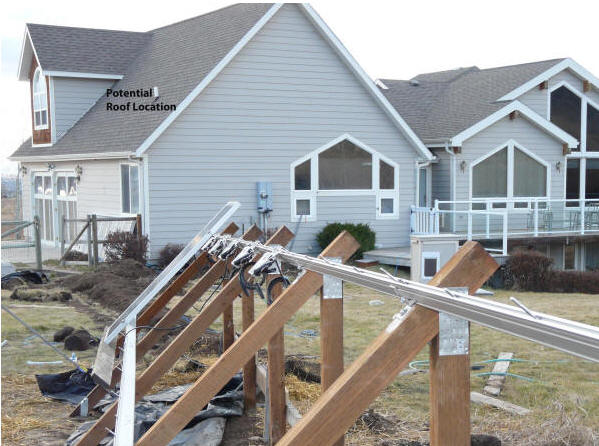
Recorded Attic Temperatures
NEW:
Another set of recorded attic temperatures for a home in
SE VA...
NEW:
Added temperatures and RH for Fall -- Winter -- Spring 2011 --
2012
Winter into start of Spring --
Mid November through end of March
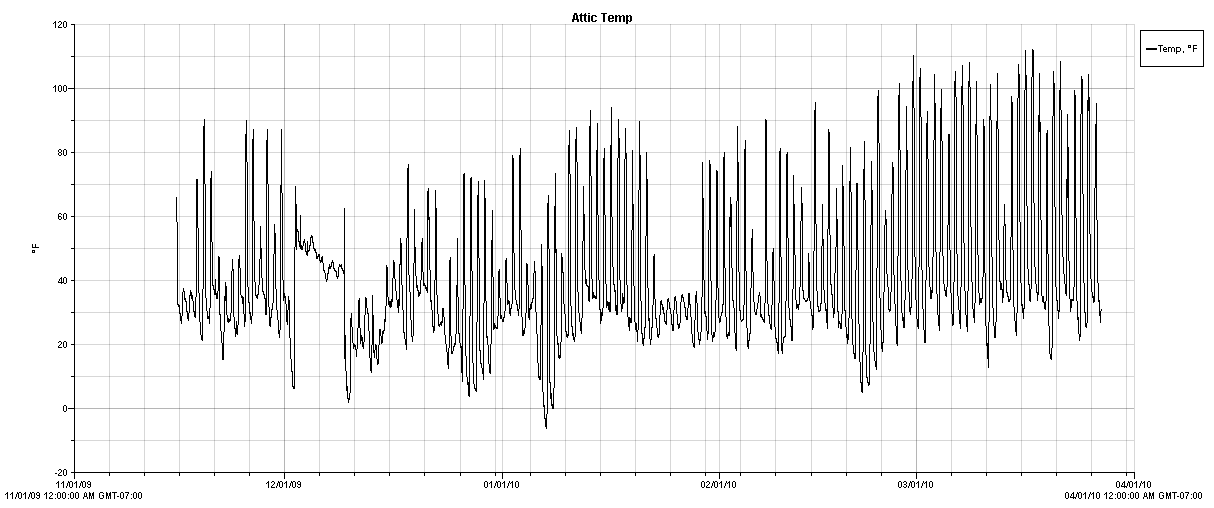
If possible, I'll keep the logger set
up through the summer and fall to get a full year.
Potential Uses of Attic Heat
Some rough conclusions so far for our
SW Montana Climate:
Space Heating
- In the mid winter, there
are only a few days when temperatures get up into the 80's, which is
pretty much the threshold for useable heating.
On most mid-winter days, the attic daily high temperatures are 70F or
less.
- In the mid-winter, on the
days that do get above 80F for the attic high, you typically have 3 to 4
hours in the mid-afternoon when temps are above 80F. This is a
time period you could presumably blow attic air down into the house and
get some free heating.
In the time period from Nov
15 through March 1, I count 22 days on which you could get some limited
heat from the attic -- about 20% of the days.
- Starting around March 1, we
got many more days with attic high temps above 80F, and quite a few days
up into the 100F area (see plot below). This appears to offer more
potential for space heating. In our climate, March is very much a
space heating month, so, it seems like there is some potential here.
My guess is that this will
also be true for early to late fall.
Domestic Water Preheating
- One thing to notice right
away is that attic temps at night can go below freezing any night during
this late fall to early spring period. Even in the spring, the
attic night lows were often down in the 20'sF. So, some sort of
protection from freezing would have to be part of any attic preheat
scheme in our climate.
- As far as the potential for
useful preheating of water, its probably similar to the space heating
story -- limited potential in mid-winter with much more starting in the
spring. In the summer, I would expect nearly every day would offer
good water preheating, but you would still want the water being
preheated to be insulated from the nighttime attic temperatures.
- In this kind of climate,
you would not just want to put a preheat tank or a big coil of pipe up
in the attic and hope for the best. You would need to insulate the
preheat tank or coil heavily, and then run the attic hot air from the
attic peak through the insulated box only when the attic peak
temperature exceeds the water tank temperature. If you don't do
this, you might well end up cooling the water rather than heating it --
not to mention the potential for freezing problems. This probably
holds true even in the summer.
Dryer Air
- One idea is to figure out a
way to draw intake air for the clothes dryer from the attic area when
attic temps are high. This way the dryer does not have to do as
much heating of the air. This seems like a potentially good idea
to me if one can figure out a workable ducting arrangement.
If you use the conventional
dryer arrangement, the dryer heats room temperature air, and then wastes
the heat by venting the heated air outside. In addition, the room
temp air the dryer uses gets replaced by infiltration of cold air from
the outside of the house. A double energy waste.
If you could do dryer loads
using attic air (when the attic is hot), and then vent the air outside,
you save the dryer some heating and you avoid pulling cold air in from
outside to replace the dryer heated air. If you live in a dry
climate, and its an electric dryer, you could go a step further and vent
the dryer air inside -- this effectively uses the same attic heat first
for drying clothes and then for heating and humidifying the house.
The dryer energy use (and potential saving) are pretty large...
In the summer, drawing the
dryer air from the attic would still be a benefit as it keeps the dryer
from having to heat the air from room temperature up to dryer
temperature. This is of the order of 4 KWH per dryer load.
You would want to vent the dry exhaust air to the outside in the summer.
Pool Heating
There is at least one
commercial pool heating solution that uses an air to water heat
exchanger in the attic to provide pool heating. Since this is a
summer demand, it seems like there is some potential here.
The car radiators that have
built in electric fans can be very effective air to water heat
exchangers, and might be worthwhile trying as pool heaters.
At any rate, I think that people tend
to go up in the attic and find it very hot, and then come to the conclusion that
its that way all the time. This may be true in some climates, but clearly
not so in Montana. That said, it does appear that there is some potential
for getting some free heat even in cold climates.
One thing that would probably help in
harvesting heat from the attic would be to put the attic venting on some type of
control that only provided attic venting in the winter when it was actually
needed. I know some of you are thinking this guy is crazy even talking
about messing with attic venting, but I would guess that the level of attic
venting is chosen for worst case combinations of temperature and humidity, and
most of the time its likely well in excess of what is needed.
More Plots of the Same Data
These are some additional views of
the same attic temperatures as are plotted above.
Same time period with Relative
Humidity and Temperature.
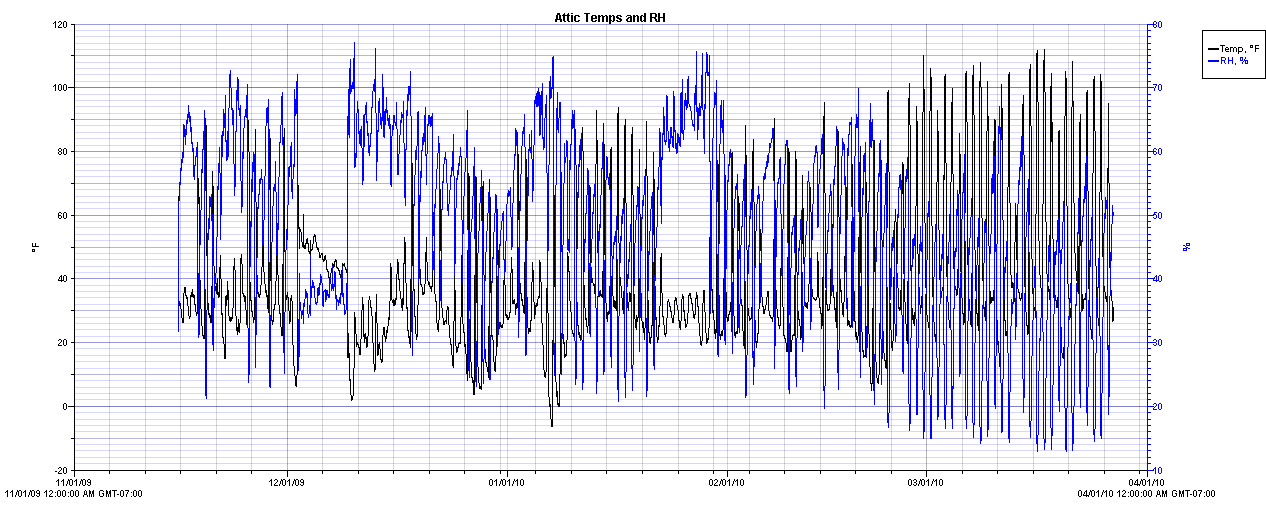
I was a bit surprised how much the
relative humidity comes up when it gets very cold -- even in our very dry
climate.
Blow up of Spring Time Period

Quite a few days with useful attic
heat.
A couple of the rare days in
mid-winter with attic temps above 80F.

Fall -- Winter --
Spring of 2011 - 2012
More temperatures for the winter and
early spring of 2011 - 2012.
The winter of 2011 -- 2012 was the
mildest winter we have had in the 11 years we have been here by quite a margin.
Just to my eyeball, the milder weather did not seem to make for much warmer
attic temperatures than the ones about for 2010.


Sensor location in attic:
Logger height off the floor: 79 inches
Ridge height from floor: 171 inches
Roof slope: 45 degrees
Logger is 41 inches east of the north wall of the attic
Total length of this attic section is 152 inches (the
rest of attic is living space)
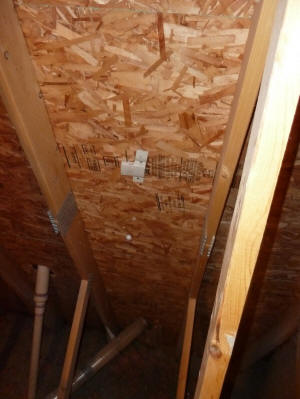
Logger in middle of rafter truss bay.
Logger case is right against sheathing. |

Onset computer temp/humidity logger |
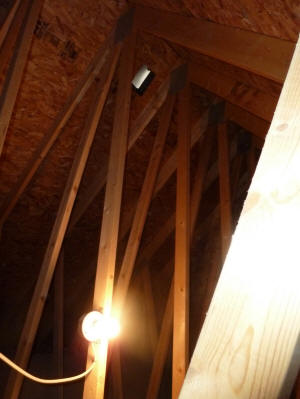
View of the attic space. The logger is
out of sight to the right. |
Gary Updated July 10, 2011










